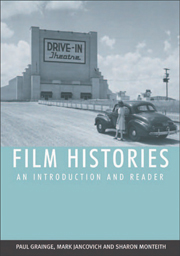Book contents
- Frontmatter
- Contents
- Preface
- Part I Film History from its Origins to 1945
- Part II Film History from 1946 to the Present
- 13 Postwar Challenges: National Regeneration, HUAC Investigations, Divestiture and Declining Audiences
- 14 The Politics of Polarisation: Affluence, Anxiety and the Cold War
- 15 Cinematic Spectacles and the Rise of the Independents
- 16 New Waves, Specialist Audiences and Adult Films
- 17 Radicalism, Revolution and Counter-Cinema
- 18 Modernism, Nostalgia and the Hollywood Renaissance
- 19 From Movie Brats to Movie Blockbusters
- 20 The Exhibitors Strike Back: Multiplexes, Video and the Rise of Home Cinema
- 21 Postmodernism, High Concept and Eighties Excess
- 22 Cults, Independents and ‘Guerrilla’ Filmmaking
- 23 From Cinemas to Theme Parks: Conglomeration, Synergy and Multimedia
- 24 Globalisation and the New Millennium
- Bibliography
- Copyright Acknowledgements
- Index
16 - New Waves, Specialist Audiences and Adult Films
from Part II - Film History from 1946 to the Present
Published online by Cambridge University Press: 05 August 2013
- Frontmatter
- Contents
- Preface
- Part I Film History from its Origins to 1945
- Part II Film History from 1946 to the Present
- 13 Postwar Challenges: National Regeneration, HUAC Investigations, Divestiture and Declining Audiences
- 14 The Politics of Polarisation: Affluence, Anxiety and the Cold War
- 15 Cinematic Spectacles and the Rise of the Independents
- 16 New Waves, Specialist Audiences and Adult Films
- 17 Radicalism, Revolution and Counter-Cinema
- 18 Modernism, Nostalgia and the Hollywood Renaissance
- 19 From Movie Brats to Movie Blockbusters
- 20 The Exhibitors Strike Back: Multiplexes, Video and the Rise of Home Cinema
- 21 Postmodernism, High Concept and Eighties Excess
- 22 Cults, Independents and ‘Guerrilla’ Filmmaking
- 23 From Cinemas to Theme Parks: Conglomeration, Synergy and Multimedia
- 24 Globalisation and the New Millennium
- Bibliography
- Copyright Acknowledgements
- Index
Summary
An examination of art films and adult cinema reveals a changing film industry at the end of the 1950s and into the 1960s as cinema's role as classic family entertainment was lost to television. Films diversified to attract different audiences, including young Americans for whom sci-fi, horror and titillation at the drive-in would guarantee a great evening out, and more specialist ‘art house’ screenings for American audiences for whom European imports held the intellectual high ground. The art house cinema circuit was typically the neighbourhood theatre in big cities where revivals of European classics such as Jean Renoir's The Rules of the Game (1939) and appreciation of more recent films such as Hiroshi Inagaki's Samurai (1954) consolidated art house cinema, differentiating it from the mass cultural products that were seen as typical of ‘American’ cinema in the 1950s. The rise of the art house as an outlet for a more diverse cinema product coincided with new cinema movements, or ‘New Waves,’ that would wash through cinema culture and change it.
In the same period, the Production Code largely administered by the studios was no longer easily enforceable. Some independent producers turned to exploitation movies, especially since in 1952 the Supreme Court extended the rights of free speech enshrined in the Fifth Amendment to the cinema in order to bring the institution in line with other media such as news.
- Type
- Chapter
- Information
- Film HistoriesAn Introduction and Reader, pp. 371 - 391Publisher: Edinburgh University PressPrint publication year: 2007



